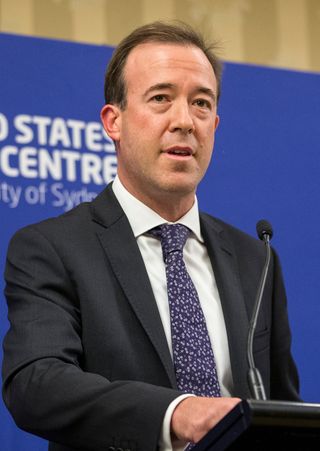The Sydney Morning Herald
By James Curran
In the contemporary strategic debate, the central challenge of our times remains the rise of China. Arguably, that means Australia is more important now to the United States than it was during the Cold War. And how to deal with Beijing's growing power and influence is driving a new sense of convergence in the relationship between Canberra and Washington. Indeed, we are witnessing an era of bipartisan support for the alliance that is unprecedented in Australia's recent history.
However, it is easy to forget just how close Australia came to losing the alliance only a matter of decades ago. Today there is too much of a tendency to gloss over those periods in the past where the US and Australian policies and priorities have clashed.
This is not to harp on divergence. Nor is it to cherry pick moments of discomfort in the Alliance. It is, rather, to better understand how both countries reacted at key moments when their respective national interests cut across each other. One can appreciate and extol the benefits and advantages that spring from the alliance without losing a sense of history, or the need, at times, for Australian autonomy.
In July 1974, after a series of bitter and heated exchanges related to the end of the Vietnam war and the shape of a new Asia, President Richard Nixon ordered the national security agencies in Washington to explore options for cutting off intelligence sharing with Australia, drastically reducing military co-operation and relocating US intelligence installations out of the country.
In a sensational report only recently declassified by the US National Archives, Nixon basically asked his top advisers whether the Alliance was worth keeping. Some hardliners in Washington, including Defence Secretary James Schlesinger, were ready to abandon Australia. Options for pressuring the Whitlam government until it collapsed were canvassed. It was the lowest point in the history of the relationship — then or since. For a time, ANZUS was perched precariously on the edge of an abyss.
The Whitlam/Nixon clash of the early 1970s cannot be dismissed as an aberration. It emerged out of two very different views of the virtual end of the Cold War in East Asia. Where Whitlam saw the advent of detente with the Soviet Union and the opening to China as a thrilling release from the ideological straitjacket of the previous two decades, and a chance to experiment with new ideas of regional co-operation, the Americans saw the cooling of tensions with Communist adversaries as fragile, a state of affairs that needed constant tendering.
This is not to say that stress and tension in the relationship only surfaced in the Whitlam era. Prime ministers Menzies, Holt, Gorton and McMahon all found that the ANZUS treaty did not necessarily translate into closer consultation with their great power ally, or that Washington would come to Australia's aid in the event of a regional crisis, particularly where Indonesia was concerned.
Today however, notwithstanding the recent frisson over whether or not Australia would join the new Asian Infrastructure Investment Bank, it could be argued that Australian leaders have largely forgotten how to disagree with the US. How to account for this?
It is surely significant that the world views of the present generation of political leaders in Australia were largely shaped, if not during the height of the Cold War, then in a period where the East-West divide was still the major factor in international relations. The post-Cold War period too was dominated by debate over the "unipolar moment" and US leadership of a "new world order". In other words, this is a generation not used to the US being on the back foot, or at least less keen to lead from the front on every global challenge.
One sometimes gets the sense that some recent Australian prime ministers are trying to force the alliance back into its Cold War mould. Thus former Prime Minister Julia Gillard's statement in her speech to a joint session of the US Congress in March 2011, that Australia is an "ally for all the years to come", while spoken with the utmost sincerity, carried more than a faint whiff of uncritical obeisance. The great irony of alliance rhetoric in the post 9/11 era is that it repeats the moral absolutes of the Cold War. It might well be a case of what historian David McLean has referred to as "too much memory".
The great risk for Australia is that sentimentalism and solemn incantations of shared values — no matter how much we all identify with and embody such values — get in the way of clear thinking about the alliance and downplay the possibilities of divergence. Of course the United States values Australia as an ally, but history shows that when it comes to its own national interests, the US, quite understandably, has been decidedly unsentimental itself. We cannot be sure if this period of convergence will necessarily continue. Few today have the gift of seeing around corners.
This is not about beating the drum of Australian nationalism all the way down Pennsylvania Ave and poking the President of the United States in the eye, or kicking him or her in the shins, simply because it feels good. But it is about respect. And it goes to the very heart of what kind of ally Washington needs in times of crisis and doubt.
Alliance razzamatazz can never be a substitute for analysis, and unqualified support rarely means Australia's distinctive interests are being protected or preserved. Today's circumstances are constantly invoked as "new" and "unprecedented", and yet the interpretative frameworks used to explain them hark back to simpler times. Still, just as in the 1970s, it is certain that Australia and the United States will once more face the dilemmas of divergence. Then, and only then, can the true nature of the alliance be really tested.
This article was orginally published at the The Sydney Morning Herald





